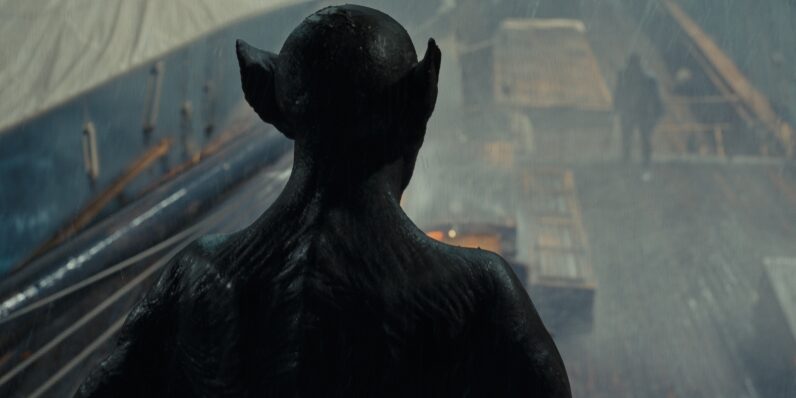
[ad_1]
A scene from ‘The Last Voyage of the Demeter’ courtesy of Universal Pictures and Amblin Entertainment
The Last Voyage of the Demeter is the rarely depicted tale of Dracula’s dark and destructive journey across the seas.
Vampires have captured the imaginations of mortals for ages. Many cultures pass down lore about monsters that hunt only at night, consuming the lives of their victims and potentially turning them into blood-lusting creatures themselves. Names and characteristics vary, as well as its weaknesses. While they’ve been romanticized since the 1800s, the last 50 years have made the undead creatures truly desirable. But some movies still dare to prescribe to the frightening beast whose features haunt one’s nightmares. That is the fiend that stalks the ship’s crew in The Last Voyage of the Demeter.
The merchant ship Demeter has been hired to carry a large shipment from Carpathia to England, earning a bonus if they can arrive on an accelerated schedule. The cargo consists of a number of heavy crates, marked with a dragon symbol that puts superstitious men on edge. Nonetheless, the ship’s crew have their eyes set on the prize, already planning how they’ll spend their windfall at the trip’s end. After an unwelcome discovery in the hold and endless storms jeopardizing their crossing, death embraces the ship, claiming victims at the regular without any logical explanation. The Demeter’s captain (Liam Cunningham), first mate (David Dastmalchian) and doctor (Corey Hawkins) do all they can to stop the murders, but they prove no match for the devil stalking the ship.
The story is based on a single chapter, titled “The Captain’s Log,” from Bram Stoker’s novel, Dracula, which chronicles the Russian schooner’s ill-fated voyage that concluded with the ship washing up on England’s shores. This part of the story is often glossed over in most adaptations, though 1922’s Nosferatu portrayed the devastation unleashed by Count Orlok on his transport. Now, the events of that doomed crossing unfold over the course of a two-hour film dedicated to unpacking the horrors recorded in the log. Voiceover relays the captain’s written account, documenting each unexplained disappearance and death.
Although audiences are aware of the vampire’s presence, it’s only gradually revealed. First fleeting glimpses hint at a monster lurking in the dark, avoiding detection and preserving the element of surprise. Movement in the shadows is seen from a distance, while close-ups expose the supernatural aspects of its form. As it grows stronger, desperation is replaced with brazen defiance as it no longer cowers in the darkness. Spanish creature actor Javier Botet does an excellent job capturing Dracula’s unnatural movements and physique, aided by five hours of special effects make-up application, accomplishing the complete opposite of Gary Oldman’s sensual fiend.
Director André Øvredal is growing his reputation as a notable genre filmmaker, having previously been endorsed by acclaimed filmmaker Guillermo del Toro. The film is well-paced, slowly building the tension and gradually wrenching the crew’s emotions. There’s a couple of character additions — a woman (Aisling Franciosi) and child (Woody Norman) — clearly meant to balance the masculine cast and appeal to a wider audience, doubling the former’s utility by also positioning her as a native versed in vampire folklore. She is effectively the warning no one chooses to heed. The picture could have used some tightening to get down to a solid one-hour and 45 minutes, but it doesn’t feel so long as to create any significant regrets. Most importantly, even though most of the movie unfolds in the dimmest of light, viewers will never find themselves straining to decrypt the images on the screen.
Universal continues its return to its horror roots, bringing another fresh take on a classic monster to the screen.
Director: André Øvredal
Starring: Corey Hawkins, Aisling Franciosi and Liam Cunningham
[ad_2]
Source link






